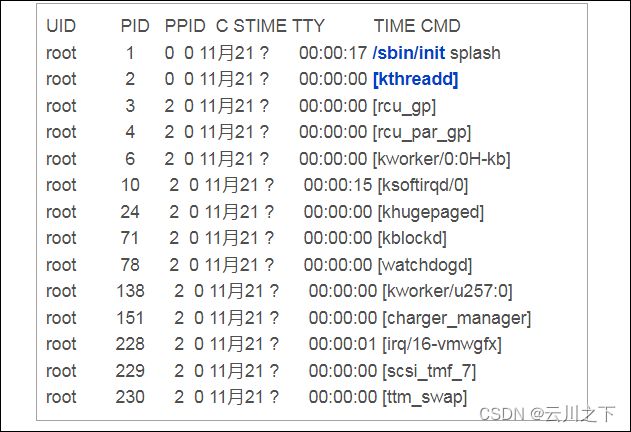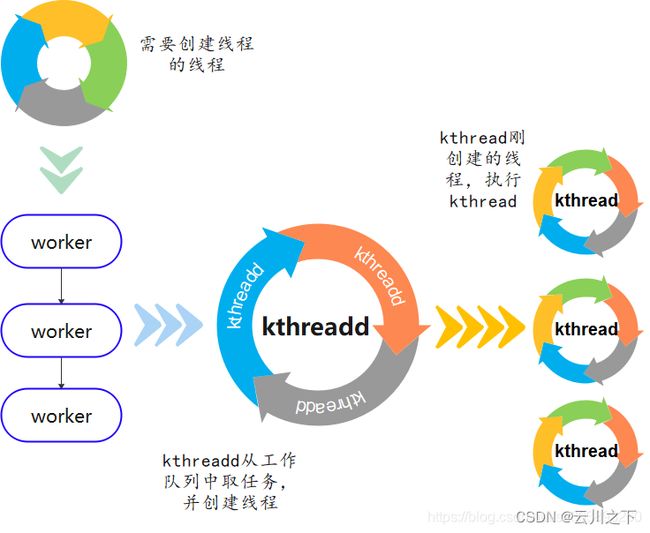Linux中的特殊进程:idle进程(0号进程)、init进程(1号进程,被systemd 取代 )、kthreadd进程(2号进程)
文章目录
- 1. Linux中的三个特殊进程:
- 2. idle进程、init进程、kthreadd进程的创建
- 3 kthreadd进程
-
- 3.1 kthreadd进程的启动
- 3.2 kthreadd进程创建子进程
- 3.3 kthreadd的工作流程总结
- 4. init进程
-
- 4.1 init进程的启动
- 4. 总结
- 参考
1. Linux中的三个特殊进程:
idle进程,或者也称为swapper进程。:
-
该进程是Linux中的第一个进程(线程),PID为0;
-
idle进程是init进程和kthreadd进程(内核线程)的父进程;
init进程:
-
init进程是Linux中第一个用户空间的进程,PID为1;
-
init进程是其他用户空间进程的直接或间接父进程;
需要注意的是,在新版本的centos系统中,已经使用 systemd 取代 init 作为1号进程
kthreadd(内核线程):
-
kthreadd线程是内核空间其他内核线程的直接或间接父进程,PID为2;
-
kthreadd线程负责内核线程的创建工作;
2. idle进程、init进程、kthreadd进程的创建
kthreadd进程是在内核初始化start_kernel()的最后rest_init()函数中,由0号进程(swapper进程)创建了两个进程:
- init进程(PID = 1, PPID = 0)
- kthreadd进程(PID = 2, PPID = 0)
在start_kernel函数中调用了rest_init函数,在rest_init函数中创建了kernel_init、kthreadd内核线程:
rest_init是idle进程调用的,因此 idle进程 是所有进程的最上层ppid,即0号进程
noinline void __ref rest_init(void)
{
struct task_struct *tsk;
int pid;
rcu_scheduler_starting();
/*
* We need to spawn init first so that it obtains pid 1, however
* the init task will end up wanting to create kthreads, which, if
* we schedule it before we create kthreadd, will OOPS.
*/
pid = kernel_thread(kernel_init, NULL, CLONE_FS); //创建init进程,入参kernel_init是进程的执行体,类似java线程的run函数
/*
* Pin init on the boot CPU. Task migration is not properly working
* until sched_init_smp() has been run. It will set the allowed
* CPUs for init to the non isolated CPUs.
*/
rcu_read_lock();
tsk = find_task_by_pid_ns(pid, &init_pid_ns);
set_cpus_allowed_ptr(tsk, cpumask_of(smp_processor_id()));
rcu_read_unlock();
numa_default_policy();
pid = kernel_thread(kthreadd, NULL, CLONE_FS | CLONE_FILES); //创建kthreadd进程,入参kthreadd是进程的执行体,类似java线程的run函数
rcu_read_lock();
kthreadd_task = find_task_by_pid_ns(pid, &init_pid_ns);
rcu_read_unlock();
/*
* Enable might_sleep() and smp_processor_id() checks.
* They cannot be enabled earlier because with CONFIG_PREEMPTION=y
* kernel_thread() would trigger might_sleep() splats. With
* CONFIG_PREEMPT_VOLUNTARY=y the init task might have scheduled
* already, but it's stuck on the kthreadd_done completion.
*/
system_state = SYSTEM_SCHEDULING;
complete(&kthreadd_done); // 等待kthreadd创建完毕
/*
* The boot idle thread must execute schedule()
* at least once to get things moving:
*/
schedule_preempt_disabled();
/* Call into cpu_idle with preempt disabled */
cpu_startup_entry(CPUHP_ONLINE);
}
3 kthreadd进程

kthreadd就是Linux的2号进程,这个进程在Linux内核中非常的重要,他是其他内核线程的父进程或者祖先进程(这个可以通过上面的PPID为2的进程可以看出,这些重要线程包括kworker、kblockd、khugepaged…),即其他进程都是通过2号进程创建的,2号进程轮询创建进程的任务队列,下面便慢慢来介绍下kthreadd进程。
3.1 kthreadd进程的启动
kthreadd是进程的执行体,我们看看这个进程干了啥?:
int kthreadd(void *unused)
{
struct task_struct *tsk = current;
/* Setup a clean context for our children to inherit. */
set_task_comm(tsk, "kthreadd");
ignore_signals(tsk);
set_cpus_allowed_ptr(tsk, housekeeping_cpumask(HK_FLAG_KTHREAD)); /*允许kthreadd在任意cpu上执行*/
set_mems_allowed(node_states[N_MEMORY]);
current->flags |= PF_NOFREEZE;
cgroup_init_kthreadd();
for (;;) {
set_current_state(TASK_INTERRUPTIBLE);
if (list_empty(&kthread_create_list)) /* 判断内核线程链表是否为空 */
schedule(); /* 若没有需要创建的内核线程,进行一次调度,让出cpu */
__set_current_state(TASK_RUNNING);
spin_lock(&kthread_create_lock);
while (!list_empty(&kthread_create_list)) { /*依次取出任务*/
struct kthread_create_info *create;
create = list_entry(kthread_create_list.next,
struct kthread_create_info, list);
list_del_init(&create->list); /*从任务列表中摘除*/
spin_unlock(&kthread_create_lock);
/* 只要kthread_create_list不为空,就根据表中元素创建内核线程 */
create_kthread(create); //创建子进程
spin_lock(&kthread_create_lock);
}
spin_unlock(&kthread_create_lock);
}
return 0;
}
从上述代码中可以看出:kthreadd进程的任务就是不断轮询,等待创建线程,如果任务队列为空,则线程主动让出cpu(调用schedule后会让出cpu,本线程会睡眠):如果不为空,则依次从任务队列中取出任务,然后创建相应的线程。如此往复,直到永远…
3.2 kthreadd进程创建子进程
从上一个章节,我们知道kthreadd进程负责轮询队列,创建子进程,那么我们看看是如何创建子进程的
创建子进程,会调用create_kthread函数,在create_kthread函数中会通过调用kernel_thread函数来创建新进程,且新进程的执行函数为kthread(类似java线程的run方法)
static void create_kthread(struct kthread_create_info *create)
{
int pid;
#ifdef CONFIG_NUMA
current->pref_node_fork = create->node;
#endif
/* We want our own signal handler (we take no signals by default). */
pid = kernel_thread(kthread, create, CLONE_FS | CLONE_FILES | SIGCHLD);/*开始创建线程,会阻塞*/
if (pid < 0) {
/* If user was SIGKILLed, I release the structure. */
struct completion *done = xchg(&create->done, NULL);
if (!done) {
kfree(create);
return;
}
create->result = ERR_PTR(pid);
complete(done);
}
}
kernel_thread接口刚才在rest_init接口中遇到过,内核就是通过kernel_thread接口创建的init进程和kthreadd进程。这里再次使用它创建新线程,新的线程执行体统一为kthead。下面我们看看kthread函数的内容:
static int kthread(void *_create)
{
/* Copy data: it's on kthread's stack */
struct kthread_create_info *create = _create;
int (*threadfn)(void *data) = create->threadfn;
void *data = create->data;
struct completion *done;
struct kthread *self;
int ret;
self = kzalloc(sizeof(*self), GFP_KERNEL);
set_kthread_struct(self);
/* If user was SIGKILLed, I release the structure. */
done = xchg(&create->done, NULL);
if (!done) {
kfree(create);
do_exit(-EINTR);
}
if (!self) {
create->result = ERR_PTR(-ENOMEM);
complete(done);
do_exit(-ENOMEM);
}
self->data = data;
init_completion(&self->exited);
init_completion(&self->parked);
current->vfork_done = &self->exited;
/* OK, tell user we're spawned, wait for stop or wakeup */
__set_current_state(TASK_UNINTERRUPTIBLE);
create->result = current;
complete(done);
schedule();/*睡眠,一直。直到被唤醒*/
ret = -EINTR;
if (!test_bit(KTHREAD_SHOULD_STOP, &self->flags)) {/*唤醒后如果此线程不需要stop*/
cgroup_kthread_ready();
__kthread_parkme(self);
ret = threadfn(data);/*执行指定的函数体*/
}
do_exit(ret);
}
从kthread函数可以看出,新线程创建成功后,会一直睡眠(使用schedule主动让出CPU并睡眠),直到有人唤醒它(wake_up_process);线程被唤醒后,并且不需要stop, 则执行指定的函数体( threadfn(data) )。
3.3 kthreadd的工作流程总结
①某一个线程A(左上那个圈)调用kthread_create函数来创建新线程,调用后阻塞;kthread_create会将任务封装后添加到kthreadd监控的工作队列中;
②kthreadd进程检测到工作队列中有任务,则结束休眠状态,通过调用create_kthread函数创建线程,最后调用到kernel_thread --> do_fork来创建线程,且新线程执行体为kthead
③新线程创建成功后,执行kthead,kthreadd线程则继续睡眠等待创建新进程;
④线程A调用kthread_create返回后,在合适的时候通过wake_up_process(pid)来唤醒新创建的线程
⑤新创建的线程在kthead执行体中被唤醒,检测到是否需要stop,在不需要stop时,执行用户指定的线程执行体。(线程执行体发生了变化:先执行默认的kthead,然后才是用户指定的threadfn,当然也可能直接执行do_exit退出线程)
4. init进程
更多init进程作用参见 【linux】init进程的详解
init进程由idle通过kernel_thread创建,在内核空间完成初始化后,加载init程序
在这里我们就主要讲解下init进程,init进程由0进程创建,完成系统的初始化,是系统中所有其他用户进程的祖先进程
Linux中的所有进程都是由init进程创建并运行的。首先Linux内核启动,然后在用户空间中启动init进程,再启动其他系统进程。在系统启动完成后,init将变成为守护进程监视系统其他进程。
所以说init进程是Linux系统操作中不可缺少的程序之一,如果内核找不到init进程就会试着运行/bin/sh,如果运行失败,系统的启动也会失败。
4.1 init进程的启动
从前文得知,创建1号进程,传入 kernel_init方法体,我们看下做了什么:
static int __ref kernel_init(void *unused)
{
int ret;
kernel_init_freeable(); //kernel_init_freeable函数中就会做各种外设驱动的初始化
/* need to finish all async __init code before freeing the memory */
async_synchronize_full();
kprobe_free_init_mem();
ftrace_free_init_mem();
free_initmem();
mark_readonly();
/*
* Kernel mappings are now finalized - update the userspace page-table
* to finalize PTI.
*/
pti_finalize();
system_state = SYSTEM_RUNNING;
numa_default_policy();
rcu_end_inkernel_boot();
do_sysctl_args();
if (ramdisk_execute_command) {
ret = run_init_process(ramdisk_execute_command);
if (!ret)
return 0;
pr_err("Failed to execute %s (error %d)\n",
ramdisk_execute_command, ret);
}
/*
* We try each of these until one succeeds.
*
* The Bourne shell can be used instead of init if we are
* trying to recover a really broken machine.
*/
if (execute_command) {
ret = run_init_process(execute_command);
if (!ret)
return 0;
panic("Requested init %s failed (error %d).",
execute_command, ret);
}
if (CONFIG_DEFAULT_INIT[0] != '\0') {
ret = run_init_process(CONFIG_DEFAULT_INIT);
if (ret)
pr_err("Default init %s failed (error %d)\n",
CONFIG_DEFAULT_INIT, ret);
else
return 0;
}
/* 调用系统根目录下的init文件,会在以下几个路径中加载init进程 */
/* 在Android源码中,init进程源码的位置为:https://www.androidos.net.cn/android/10.0.0_r6/xref/system/core/init/init.cpp */
if (!try_to_run_init_process("/sbin/init") ||
!try_to_run_init_process("/etc/init") ||
!try_to_run_init_process("/bin/init") ||
!try_to_run_init_process("/bin/sh"))
return 0;
panic("No working init found. Try passing init= option to kernel. "
"See Linux Documentation/admin-guide/init.rst for guidance.");
}
- kernel_init_freeable函数中就会做各种外设驱动的初始化
- 最主要的工作就是调用 init可以执行文件,即开机自动运行的程序,通过Init配置文件在约定的路径下,会被自动读取
至此1号进程就完美的创建成功了,而且也成功执行了init可执行文件
4. 总结
总结:
- linux启动的第一个进程是0号进程,是静态创建的
- 在0号进程启动后会接连创建两个进程,分别是1号进程和2和进程。
- 1号进程最终会去调用可init可执行文件,init进程最终会去创建所有的应用进程。
- 2号进程会在内核中负责创建所有的内核线程
- 所以说0号进程是1号和2号进程的父进程;1号进程是所有用户态进程的父进程;2号进程是所有内核线程的父进程。
我们通过ps命令就可以详细的观察到这一现象:
root@ubuntu:zhuxl$ ps -eF
UID PID PPID C SZ RSS PSR STIME TTY TIME CMD
root 1 0 0 56317 5936 2 Feb16 ? 00:00:04 /sbin/init
root 2 0 0 0 0 1 Feb16 ? 00:00:00 [kthreadd]
上面很清晰的显示:PID=1的进程是init,PID=2的进程是kthreadd。而他们俩的父进程PPID=0,也就是0号进程。
再来看下,所有内核线性的PPI=2, 也就是所有内核线性的父进程都是kthreadd进程。
UID PID PPID C SZ RSS PSR STIME TTY TIME CMD
root 4 2 0 0 0 0 Feb16 ? 00:00:00 [kworker/0:0H]
root 6 2 0 0 0 0 Feb16 ? 00:00:00 [mm_percpu_wq]
root 7 2 0 0 0 0 Feb16 ? 00:00:10 [ksoftirqd/0]
root 8 2 0 0 0 1 Feb16 ? 00:02:11 [rcu_sched]
root 9 2 0 0 0 0 Feb16 ? 00:00:00 [rcu_bh]
root 10 2 0 0 0 0 Feb16 ? 00:00:00 [migration/0]
root 11 2 0 0 0 0 Feb16 ? 00:00:00 [watchdog/0]
root 12 2 0 0 0 0 Feb16 ? 00:00:00 [cpuhp/0]
root 13 2 0 0 0 1 Feb16 ? 00:00:00 [cpuhp/1]
root 14 2 0 0 0 1 Feb16 ? 00:00:00 [watchdog/1]
root 15 2 0 0 0 1 Feb16 ? 00:00:00 [migration/1]
root 16 2 0 0 0 1 Feb16 ? 00:00:11 [ksoftirqd/1]
root 18 2 0 0 0 1 Feb16 ? 00:00:00 [kworker/1:0H]
root 19 2 0 0 0 2 Feb16 ? 00:00:00 [cpuhp/2]
root 20 2 0 0 0 2 Feb16 ? 00:00:00 [watchdog/2]
root 21 2 0 0 0 2 Feb16 ? 00:00:00 [migration/2]
root 22 2 0 0 0 2 Feb16 ? 00:00:11 [ksoftirqd/2]
root 24 2 0 0 0 2 Feb16 ? 00:00:00 [kworker/2:0H]
UID PID PPID C SZ RSS PSR STIME TTY TIME CMD
root 362 1 0 21574 6136 2 Feb16 ? 00:00:03 /lib/systemd/systemd-journald
root 375 1 0 11906 2760 3 Feb16 ? 00:00:01 /lib/systemd/systemd-udevd
systemd+ 417 1 0 17807 2116 3 Feb16 ? 00:00:02 /lib/systemd/systemd-resolved
systemd+ 420 1 0 35997 788 3 Feb16 ? 00:00:00 /lib/systemd/systemd-timesyncd
root 487 1 0 43072 6060 0 Feb16 ? 00:00:00 /usr/bin/python3 /usr/bin/networkd-dispatcher --run-startup-triggers
root 489 1 0 8268 2036 2 Feb16 ? 00:00:00 /usr/sbin/cron -f
root 490 1 0 1138 548 0 Feb16 ? 00:00:01 /usr/sbin/acpid
root 491 1 0 106816 3284 1 Feb16 ? 00:00:00 /usr/sbin/ModemManager
root 506 1 0 27628 2132 2 Feb16 ? 00:00:01 /usr/sbin/irqbalance --foreground
所有用户态的进程的父进程PPID=1,也就是1号进程都是他们的父进程。
参考
Linux中的特殊进程:idle进程、init进程、kthreadd进程
Linux内核学习之2号进程kthreadd
Linux0号进程,1号进程,2号进程
